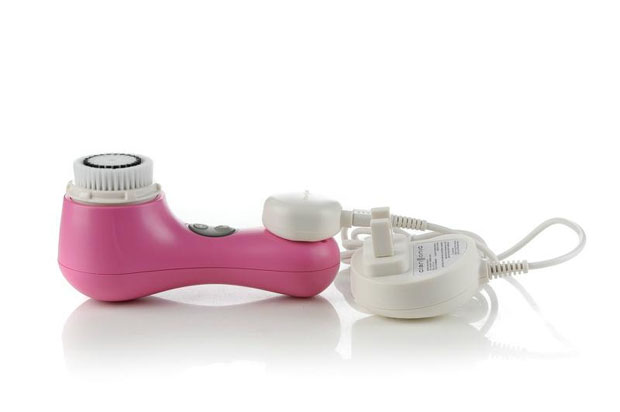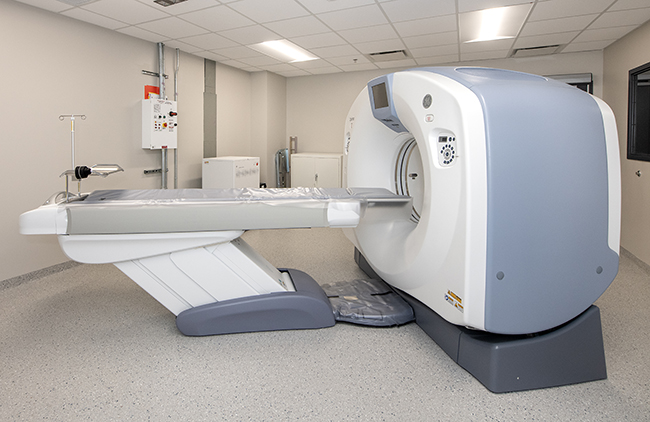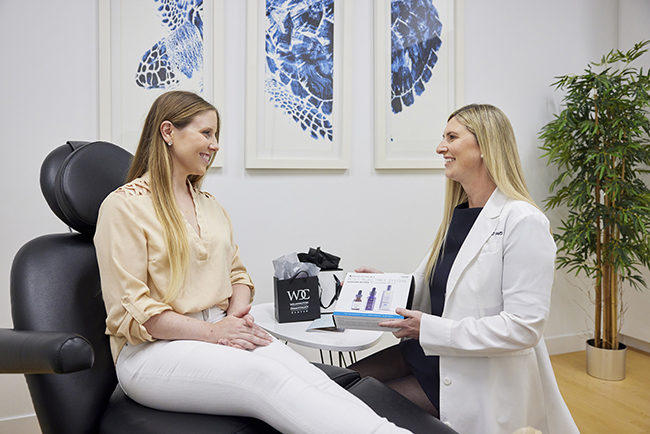Take Care of the Skin You’re In
15 Mar 2015
Local experts weigh in on skin care regimens and treatment options for those of us lucky enough to live near the beach
By ANDREA BARILLA

We are blessed to live on the coast, but living in a warm, sunny climate has its costs. Such proximity to the sun puts us at greater risk for premature aging (e.g., wrinkles, sunspots) and skin cancer. So how can we coast-dwellers take care of our skin, especially as we head into the warmer months? For answers, we turned to the experts.
Drink Water
“Drink lots of water to keep your skin naturally moisturized and hydrated,” says Kate Jackson, M.S., PA-C, of DermOne (Atlantic Dermatology). If it’s not your beverage of choice, consider flavoring it with lemon or a drop of juice.
Eat Antioxidant-Rich Foods
Generally found in brightly colored fruits and vegetables, antioxidants “help protect your skin from free radicals, which cause skin damage and destroy collagen, creating wrinkles,” says Jackson.
Apply Sunscreen
Because we live in a temperate climate and are outside year-round, it’s essential we apply sunscreen every day. “People forget the incidental sun exposure they’re getting when they take a run, walk the Loop, even walk to their cars,” says Dr. Rosalyn George of Wilmington Dermatology Center. These incidental exposures add up, leading to wrinkles, sunspots, and a greater risk for skin cancer. According to the American Academy of Dermatology (AAD), one in five Americans is expected to develop skin cancer in their lifetime.
Consider Sun-Protective Clothing
Commonly found in outdoor and sports stores, sun-protective clothing follows the ultraviolet protection factor (UPF) system. “Clothing with a UPF of 30 is effective,” says Jackson. A hat is always a good idea, as well.
Avoid Tanning Beds
According to the AAD, melanoma is the most common form of cancer for young adults 25 to 29 and the second most common for those 15 to 29. Tanning beds increase the risk for melanoma, especially in women ages 45 and under. “Using a tanning bed is like paying someone to give you cancer,” says Dr. George. “You’re basically frying your skin with excessive UV light. A few minutes in a tanning bed is like being outside all day.”
Visit Your Dermatologist at Least Once a Year (and for Anything Suspicious)
“If you have something on your skin that is changing or doesn’t seem right—I call it the ‘ugly duckling spot’—don’t wait. Have it checked, even by your regular doctor. Skin cancer is very easily treated if you catch it early,” says Dr. George.
Dr. Edward Ricciardelli of Summit Plastic Surgery & Dermatology says to pay attention to any scaly or itchy areas that don’t heal or that keep coming back and to any areas on the skin that are bleeding, burning, or tender. “A lot of times our surgical skin-cancer patients tell us they thought they just nicked themselves shaving, but the lesion kept coming back,” he says
Exfoliate
“Spring is the perfect time to exfoliate,” says Jackson. “During winter months, exfoliants tend to be too harsh on our skin, causing irritation and dryness. Exfoliation removes dead skin cells from your skin’s surface, promoting healthy, smooth skin. [In-home] treatments include topical retinoids, alpha hydroxy acid (e.g., glycolic acid, lactic acid) cleansers and moisturizers, and body scrubs.” She suggests using alpha hydroxy moisturizers on your feet to make them smooth and pretty for your sandal debut.
Try Retinols and Collagen-Boosting Serums
Dr. George sees retinols (Retin-A, etc.) as a nonnegotiable. These vitamin A derivatives gently slough off dead skin while also boosting collagen production. She recommends prescription retinols, as the over-the-counter brands are not stabilized. She also recommends collagen-boosting serums, such as TNS Essential Serum. Why is collagen production so important? Says Jackson, “The natural aging process, combined with sun exposure and pollution, destroys collagen, which is the main protein of the skin’s connective tissue that prevents volume loss and wrinkles.”
Combat Body Acne
Staying in your sweaty workout wear is a major cause for body acne; wetsuits also contribute. Take a shower after working out, and consider over-the-counter washes with salicylic acid or benzoyl peroxide. Dr. George prefers benzoyl peroxide washes of 10 percent.
Consider the Clarisonic
Both Dr. George and Jackson rave about the Clarisonic, a product that does for your skin what an electric toothbrush does for your teeth. “It gets off all the sunscreen gunk and summertime oil so that your pores don’t get clogged,” says Dr. George.
More Advanced Skin-Care Treatments
The following treatments go beyond basic skin care, but are good tools to make use of should your skin need them. Your dermatologist can recommend the right approach for you.
Chemical Peels
Chemical peels help with sun damage, fine wrinkles, skin discoloration, acne scars, and precancerous lesions. They also help with acne as they declog the pores and reduce skin inflammation. With this treatment, a chemical is applied to the top layer of your skin, causing it to separate from the bottom layer. “You get a peeling, you flake, similar to how a snake sloughs its old skin,” says Dr. George. There are different levels of peels based on your goals.
Micro-Needling and Mild Lasers
Micro-needling and mild lasers, such as the Clear + Brilliant, microscopically “‘wound’ the skin so the skin’s own collagen reforms,” says Dr. George. She likens it to tilling the land, getting it ready for planting—in this case, for new and fresh skin. These treatments are typically used on the face, neck, and chest. The procedure requires minimal downtime.
Fraxel
Fraxel lasers go a little deeper than mild ones. Dr. George uses the Fraxel Dual, a special laser that targets wrinkles, acne scarring, and brown spots on the face, neck, and chest. It’s also great for melasma, also termed “the mask of pregnancy,” a common skin condition characterized by brown or gray-brown patches on the face. Melasma is triggered by sun exposure and hormone changes (such as those that occur in pregnancy, with birth control, and with hormone-replacement therapy). Just as with the milder laser treatments, patients are given a numbing agent, and the laser, a handpiece with two roller balls on the end, is rolled over the problem areas. Patients often reach their desired goals in three to six visits.
CO2 Lasers
DermOne provides treatments using a SmartSkin CO2 fractional laser, which “uses light energy to bore tiny holes in the skin, stimulating collagen production; it’s also the gold standard for wrinkle reduction,” says Jackson. She has started using this laser on the delicate eye area and is seeing great results for eyelid sag and under-eye circles.
Surgical CO2 Laser Resurfacing
“This is for men and women who’ve had a lifetime of sun damage and a lot of wrinkles, pigmentation, and/or precancerous lesions,” says Dr. Ricciardelli. He likens this CO2 to a deep chemical peel, as he uses the laser to remove the deeper layers of the dermis (thus the need for an anesthetic), but “when it heals, the collagen and the deep dermis are completely restructured and repaired, so you have a very smooth skin surface.” Healing takes about two weeks.
Blue Light Therapy
Blue light therapy is effective in destroying precancerous cells. It involves a photosensitive cream being applied to the problem areas. The abnormal cells absorb the cream, and once the area is put under a blue light, the solution is activated. It then breaks down the precancerous cells.
Sunscreen Essentials
- Use sunscreen with at least SPF 30. It should be labeled broad-spectrum (broad-spectrum protects from all the different UV rays).
- Apply it at least 20 minutes before going outside.
- Reapply every two hours or more often if you are in the water or doing something sweat-producing.
- If you use a spray lotion, rub it in. “If you just spray it on, half the sunscreen is lost in the air,” says Dr. George.
- If sunscreen burns your eyes, “wear a hat and sunglasses and apply it from the eyes down,” she advises.
- If you have acne-prone skin, choose a sunscreen that says “oil-free” or “noncomedogenic.”
Use it year-round. Make sunscreen application a daily habit by adding it to your morning grooming routine.














